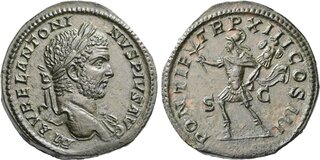| Numismatica Ars Classica > Auction 144 with CNG & NGSA | Auction date: 8 May 2024 |
| Lot number: 1120 Price realized: This lot is for sale in an upcoming auction - Bid on this lot  | Show similar lots on CoinArchives Find similar lots in upcoming auctions on |
| Lot description: The Geoffrey Cope Collection of Ancient Greek and Roman Bronzes. The Roman Empire. Caracalla, 198 – 217. Description Sestertius, Roma 210, Æ 33 mm, 24.60 g. M AVREL ANTONI – NVS PIVS AVG Laureate head r., with drapery on l. shoulder. Rev. PONTIF TR P XIII COS III S – C Mars, in military attire, striding l., holding branch and trophy. Reference C 474 var (without drapery) BMC 202 RIC 450b Condition A superb portrait of fine style struck in high relief and a lovely brown-green patina gently smoothed. Minor traces of double striking, otherwise good extremely fine Provenance Spink's Zürich sale 23, 1987, 928 Waddell sale II, 1987, 540 CNG-NAC sale 40, 1996, 1580 Triton sale I, 1997, 1546 From the James Fox collection Note: The brilliantly-executed and powerful portrait of Caracalla on the obverse of this sestertius serves to underline his role as a conquering soldier-emperor. He sports a short military hairstyle that would fit easily under a helmet and a campaign beard that might also have been intended to invoke images of his great, but much-longer bearded father, Septimius Severus. Although this portrait does not have the full angry look of many of Caracalla's later portraits, it does include his trademark furrowed brow as if to convey his contempt for the enemy. Such a portrait type was very much appropriate for 210, a year in which Caracalla was campaigning, alongside his father and his hated brother Geta against the Caledonians who threatened the northern frontier of Britannia. Following a series of Caledonian invasions, in 208 the three emperors crossed the English Channel to push back the invaders and end all possibility of future incursions. In 209, they suffered heavy losses from the enemy's guerrilla tactics, but reclaimed the territory between Hadrian's Wall and the Antonine Wall by reoccupying old forts from the time of Agricola and adopting a scorched earth policy of devastation that brought many of the Caledonian tribes to seek peace. Nevertheless, in 210, Caracalla mounted a punitive campaign across the Antonine (to continue on next page) Estimate: 10000 CHF |  |



